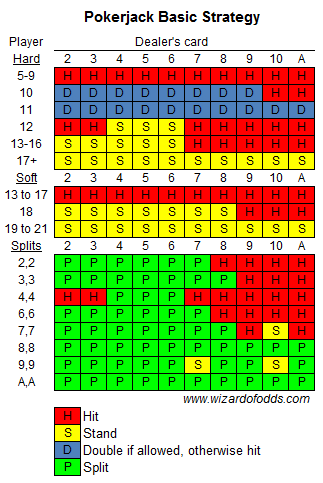On this page
Pokerjack
Introduction
Pokerjack is a blackjack game with two poker-based side bets. The game is by Arrow's Edge, a software company providing games to Internet casinos.
Rules
The rules of the blackjack wager are as follows:
- One deck of cards is used.
- Dealer hits a soft 17.
- Dealer peeks for a blackjack.
- Player may double on 10 or 11 only.
- Double after split allowed.
- Player may not re-split.
- No surrender
The rules of the Poker and Jackpot wagers are as follows:
- If the player stands or busts with fewer than five cards, then dummy cards will be dealt to complete a five-card poker hand. These cards shall not affect the blackjack wager.
- If the player draws to six or more cards, then the first five shall be used to adjudicate the Poker and Jackpot bets.
- If the player gets a pair and splits, then he must also split the Poker and Jackpot bets. As in blackjack, the player must double his wager and each initial card in the pair will be used as the first card of a separate hand.
- The pay table for the Poker and Jackpot bets are shown in the table below. For the Poker bet, all wins are on a "to one" basis. For the Jackpot bet, all wins are shown as a percentage of the progressive meter and are paid on a "for one" basis.
Poker and Jackpot Bet Pay Tables
| Hand | Poker Bet | Jackpot Bet |
|---|---|---|
| Royal flush | 500 | 100% |
| Straight flush | 100 | 10% |
| Four of a kind | 50 | 5% |
| Full house | 10 | 2% |
| Flush | 8 | 1% |
| Straight | 5 | |
| Three of a kind | 3 | |
| Two pair | 2 | |
| Pair (sevens or better) | 1 |
Analysis
Assuming total-dependent basic strategy, using my blackjack house edge calculator, the house edge of the blackjack game alone is 0.38%.
The following table shows the probability and return of each hand, assuming five random cards. The lower right cells shows a house edge of 18.13% (ouch!).
Poker Bet Analysis
| Hand | Pays | Combinations | Probability | Return |
|---|---|---|---|---|
| Royal flush | 500 | 4 | 0.000002 | 0.000770 |
| Straight flush | 100 | 36 | 0.000014 | 0.001385 |
| Four of a kind | 50 | 624 | 0.000240 | 0.012005 |
| Full house | 10 | 3,744 | 0.001441 | 0.014406 |
| Flush | 8 | 5,108 | 0.001965 | 0.015723 |
| Straight | 5 | 10,200 | 0.003925 | 0.019623 |
| Three of a kind | 3 | 54,912 | 0.021128 | 0.063385 |
| Two pair | 2 | 123,552 | 0.047539 | 0.095078 |
| Pair (sevens or better) | 1 | 675,840 | 0.260042 | 0.260042 |
| All other | -1 | 1,724,940 | 0.663704 | -0.663704 |
| Total | 2,598,960 | 1.000000 | -0.181286 |
Assuming five random cards, the break-even meter for the Jackpot bet to have zero house edge is $15,774.22. The return per $1,000 in the meter is 6.34%. At the time of this writing on Nov. 2, 2015, the meter was at $3,581, for a return of only 22.7%.
Please note that for both side bets I wrote "based on five random cards." If the players first two cards are a pair he may wish to split them, which would be detrimental to the value of both the Poker and Jackpot bets. I haven't worked out the value of a hand after splitting, but it would obviously be less than the value of a hand where the first two cards were paired.
Strategy
Following is the basic strategy for these blackjack rules assuming no side bets.

As mentioned in the rules, if the player wants to split a pair, he has to split the Poker and Jackpot side bets too. This will cause an incentive to not split, increasing the house edge of the blackjack game. When the player does split, it will increase the house edge of the two side bets. Depending on the exact bet amounts and size of the jackpot, there will be an optimal splitting strategy to maximize the combined expected value of all three bets. Please forgive me if I do not spend all day calculating this strategy. For a $1 jackpot bet, that may go positive once every several years, I don't think this will rank very high as a viable advantage play.


